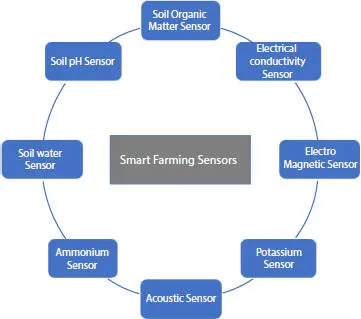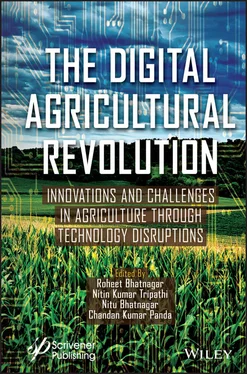1 ...6 7 8 10 11 12 ...20
1.5.3 Weed and Pest Control
India needs 400 million tons of food to feed nearly 1.7 billion people by 2050 [12]. The food production decreases due to irregular climate which favors weed growth and thereby reduces the yield and quality of production. Many researchers in India studied the economic loss due to the presence of weeds. According to Sahoo and Saraswat, the loss was estimated to be INR 28 billion in the last two decades [8]. Bhan et al. [9] estimated that the 31.5% of reduction is mainly due to weeds. Varshney and Babu [10] estimated an economic loss of INR 1050 billion/year. Yogita et al. [11] estimated about 11 billion dollars lost due to weeds. The major crop which estimated economic losses is groundnuts, maize, soybean, wheat, rice, and so on [11, 28]. It is reported that about one third of total losses are because of weeds [13]. Despite efforts taken by weed management, weeds are considered to be a serious issue for different crops and other ecosystems. The main challenges faced by Indian farmers are as follows [36]:
1 (i) managing weeds in small area cultivation,
2 (ii) inadequate labor and modern tools,
3 (iii) less information about weed biology,
4 (iv) impact of climate change on growth of weeds,
5 (v) lack of knowledge in usage of herbicide which kills the weeds.
Various weed managements are prevailing, namely chemical, mechanical, biological, and cultural control. It is difficult to manage the weed effectively using single weed management. The use of integrated weed practices is suggested by many researchers [14–20] for major crops like rice, wheat, finger millet, maize, cotton, groundnut, and so on [29]. In a nutshell, it is proven that the herbicides combined with hand weeding help in removing weeds and increase crop production [21]. However, location-specific weed management with AI technology is necessary for Indian crops.
In India, because of diverse climatic conditions, water management is not effective. Modern technologies are being used—thermal imaging camera, which monitors the crop determines whether it is getting adequate water. It is reported that water scarcity in India can lead to about 6% of the Gross Domestic Product (GDP) by 2030. The researchers also predicted that about 70% of groundwater is being pumped faster than estimated [23]. It is high time to look into the overpumping of groundwater. Artificial Intelligence coupled with image processing techniques helps in proper water management thereby increasing yield.
It is reported that about 40% of the annual agricultural cost is being spent on labor employment. Nowadays, AI-based robots are being deployed to reduce labor costs. Artificial Intelligence also finds application in supply chain management [22] for crops.
1.6 Indian Agriculture and Smart Farming
As the population increases, the traditional methods of agriculture are not suitable, and adopting the latest technologies is essential for improving productivity and farmers’ income. The revolution in the latest technologies like Big Data, Cloud Computing, Internet of Things, and Satellite, and Drone-based image analysis has made a big impact in many Indian industries from IT to health care. Nearly 450 start-ups from India are using the latest technologies like AI, ML, blockchain, big data, drones, and IoT with the main aim of increasing agricultural productivity [24]. Gobasco is a private concern in Lucknow which offers an online marketplace for best buying and selling supply goods. Gramophone in Indore provides chatbots for farmers, which help farmers to have better crop cycles. Jivabhumi, Bengaluru uses blockchain technology to bridge the gap between farmers and consumers. Digital farming is adopted in the states of Gujarat, Maharashtra, and Rajasthan by Agrostar, Pune, which helps farmers 24/7 to know the crop requirements along with required services [26].
According to the NASSCOM report 2019, smart farming is predicted to reach 23.14 billion dollars by 2022. The following are some of the smart farming applications:
precision farming uses IoT sensors in the field, and farmers can view the data through mobile applications;
agricultural drones manage large farms using airborne sensors, which are capable of collecting thermal and visual data;
livestock monitoring helps to detect sick animals;
smart greenhouses use solar-powered sensors, which help the farmer remotely turn on/off the lights, fan, monitor temperature, and humidity, and so on;
smart irrigation uses a sprinkler system along with an alert system;
farm management system for collecting and storing sensor data in the cloud and access through various devices and applications;
apart from soil health monitoring, optimal seed sowing, water management, and weed management, AI also helps in identifying plant diseases.
1.6.1 Sensors for Smart Farming
Sensors collect data from crops, livestock, soil, and the atmosphere. The sensor data are supplied to a cloud-based IoT platform with preprogrammed decision rules and models that determine the status of the studied object and highlight any flaw or requirement. Following the discovery of difficulties, the IoT platform’s user and/or ML-driven components assess whether and which location-specific treatments are required. Various sensors used for smart farming are shown in Figure 1.8.
Electromagnetic sensors detect the ability of soil particles to conduct or acquire electrical charge using electric circuits. The electrical conductivity of the soil is immediately recorded in a logger after it becomes a member of the electromagnetic circuit. To measure electrical conductivity, contact EC sensors use electrodes and make contact with the soil. The data, as well as the position information, are stored in a data logger. Contact EC sensors are highly common in precision agriculture because of their large area coverage and less prone to outside interference.

Figure 1.8 Various sensors for smart farming.
Optoelectronic devices allow for such interaction. In general, optoelectronic sensors use the properties of various materials to create a spectral signature. A common type of sensor in this category is the soil organic matter (SOM) sensor that uses the optical method.
An ion-selective electrode is used for some measurements. The activity of certain ions is detected by these electrodes. The mechanical resistance of the soil is measured by mechanical sensors. Airflow sensors are used to determine the air permeability of the soil. The sensor detects the pressure required to compress a specific volume of air into the soil at a specific depth.
Acoustic sensors: The change in noise level caused by the tool’s interaction with the soil particles is used to evaluate soil texture. Soil pH sensors detect acidity and alkalinity in the soil, which can lead to fertility issues, stunted growth, oddly colored leaves, and poor plant health. Ammonium sensors detect exact ammonia and nitrogen concentration and nitrate sensors are devices that detect the presence of nitrate in the soil or water.
Potassium sensors: These devices monitor potassium levels in the soil to better understand the relationship between free potassium in soil nutrients reserves, soil texture, and root growth, which could lead to more efficient fertilizer use. Soil-water sensors are useful for detecting local energy and water balances, delivery of applied chemicals to plants and groundwater, irrigation management, and precision farming.
Читать дальше













